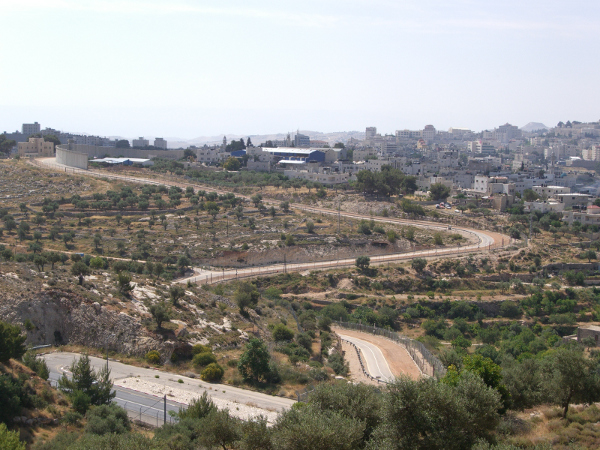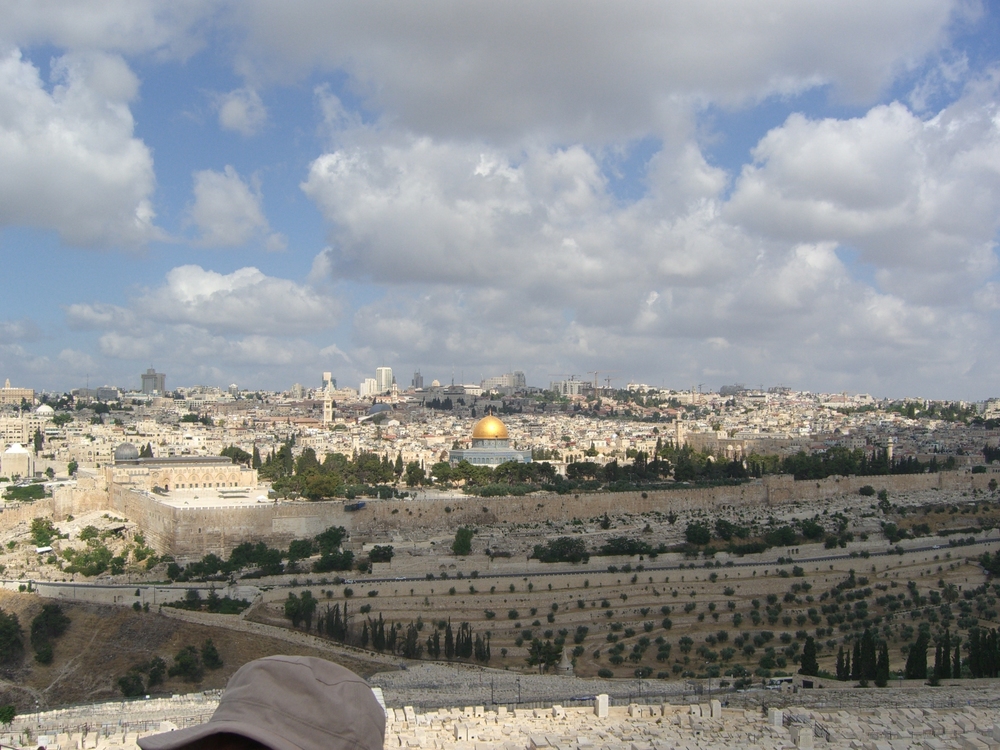On our first day in Israel, after landing at Ben Gurion airport in Tel Aviv, we got on the bus to Jerusalem, and after only a few miles we stopped. We got off the bus and looked around; we were in the middle of nowhere. The land was rocky, dry, and hot. We were each given a small hoe and a twig—a twig no more than eight or nine inches long, with maybe seven tiny leaves on one end and a few roots on the other, and we went and dug holes in the rocky, dry, hot dirt, and we each planted one tree. They were oaks, we were told, but they didn’t look mighty at all; tender little things they were, softly asking us to take care of them, but we splashed some water on them, said a prayer, got back on the bus, and drove on. Out of the sixteen we planted, perhaps only one or two will grow and flourish, but that will be enough to continue to heal and restore the land.
The moment reminded me of a story I have long loved. It’s of a hiker in the mountains in the south of France who one day, while looking for water, met a shepherd who invited him to spend the night.
I gratefully accepted. We gathered his sheep and walked to his cabin in a steep valley. After dinner, the Shepherd left the room and returned with a small sack. He dumped the contents – about two hundred acorns – out on the table. He scrutinized each one carefully and sorted them into piles. He discarded all with cracks. Through this process he eventually ended up with ten piles of ten acorns each. He placed this carefully selected piles of acorns into a bucket of water, then showed me to a corner where I unrolled by blanket and made my bed for the night.
The next day, he invited me to join him as he walked to the top of a nearby ridge. He carried an iron staff the thickness of my thumb and about shoulder height in length. As we reached the top of the ridge, the Shepherd began poking his staff into the ground, making small holes about two inches deep. Into each he placed one of his carefully selected acorns. He was planting trees. I asked if this was his land. It was not – he did not know who owned it. Perhaps it was common land, or owned by the parish. It did not matter to him. With the same care with which he seemed to do everything, he planted one hundred acorns.
At midday, he returned to his home for lunch. Afterward, he again sorted out one hundred acorns. When I told him that in thirty years his ten thousand oaks would be a magnificent forest, he responded by saying that if God granted him health, in thirty years these ten thousand oaks would be but a drop in the ocean.
The story is based on the life of Elzéard Bouffier who, after the death of his wife and son, moved to the mountains, and over a period of fifty years planted hundreds of thousands of trees.
He began planting trees, he said, because the land was dying for want of trees, and he had nothing more important to do.[1]
Jesus teaches that the kingdom of God is as if someone would scatter seed on the ground, and would sleep and rise night and day, and the seed would sprout and grow, how, he does not know. Jesus doesn’t give us a timetable for the coming of the kingdom of God, nor does he provide a blueprint or a constitution for that wondrous realm of peace. Instead of answers to our questions of when and how and where, he gives us stories with shepherds and gardeners, trees and birds in them – parables that explain very little. Who is this gardener who scatters seed on the ground, and then nothing is mentioned about watering or weeding or keeping the rabbits away? Are we to think of God as the gardener or Jesus, or perhaps anyone who plants seeds trusting that they will grow? Are we to think of ourselves as gardeners or as the soil in which the seed of Jesus’ life and teachings take root and flourish into a harvest of life, and we don’t know how? Or are we to think of ourselves as perhaps both the soil and the gardener, in turn receiving and spreading the powerful little seeds of God’s reign?
“We have so little to do with Christ’s nearness to us,” says Wendy Farley, “that we can just go to sleep. In fact, it might be better if we did sleep through the whole thing, snug and safe, resting like babies in our mothers’ arms.” No doubt, the man who planted trees rested like a baby every night. No need to go back day after day, anxious to see how the acorns were doing. He simply got up every morning and went out to poke holes in the soil and plant seeds, because he had nothing more important to do.
Martin Luther clearly saw himself as a sower when he wrote, “I simply taught, preached, and wrote God’s Word; otherwise I did nothing. And while I slept or drank Wittenberg beer with my friends Philip and Amsdorf, the Word so greatly weakened the papacy that no prince or emperor ever inflicted such losses on it. I did nothing; the Word did everything.” You can enter the parable imagining yourself to be the gardener, or the seed, or the soil, and each entrance takes you into a different story that is still the same parable. Once the seed is in the ground, the miracle happens, we don’t know how. Parables resist complete explanation; they aren’t locked treasure boxes that reveal their splendor only to those who find the proper key. No, they are living stories that mess with our presumptions, surprise and confound us, revealing ever new facets of meaning to those who live with them as companions on the way to the kingdom. Parables just won’t sit still long enough so we can turn them into simple one-liners we can add to our list of the facts of life. Parables don’t offer answers that settle things, but rather point us back, again and again, to the one who speaks the word to us with many such stories that keep us wondering and who is himself for us the parable of God.
“With what can we compare the kingdom of God,” Jesus asks, “or what parable will we use for it?” And he wanders the whole realm of nature, teeming with mighty creatures like the lion and the eagle, the bull and the bear, creatures gladly chosen by human empires as symbols of power, but conspicuously absent from Jesus’ stories of God’s reign. If not one of those emblems of strength, how about the mighty trees that since the days of the prophets represented the great empires?
Consider Assyria, a cedar of Lebanon, says Ezekiel: beautiful branches, forest shade, towering height; indeed, its top went up between the clouds. Waters nourished it, the deep raised it up, making its rivers flow around the place it was planted, sending forth its streams to all the trees of the field. So it towered high above all the trees of the field; its boughs grew large and its branches long, from abundant water in its shoots. All the birds of the air made their nests in its boughs; all the animals of the field gave birth to their young under its branches; and in its shade all great nations lived. It was beautiful in its greatness and in its lush foliage; for its roots went down to abundant water.[2]
Ezekiel dreamed of God planting a tender shoot on Israel’s mounainous highlands, and how it would send out branches and bear fruit. How it would grow into a mighty cedar, and birds of every kind would nest in it and find shelter in the shade of its boughs.[3]
“With what can we compare the kingdom of God,” asks Jesus, “or what parable will we use for it?” How about the mighty cedar, the majestic oak, or the elegant and generous date palm? There are so many to choose from, but Jesus returns from his nature walk holding up – a mustard seed.
Many of us barely remembered that mustard is a plant; we know it primarily as the stuff in yellow bottles we squeeze on our hot dogs. Some of us may note how every time we clean out the fridge we find another handful of the little plastic packets, left over from some burger we brought home who knows when, and we wonder how long they have been hiding behind the ketchup. The mustard seed may be small, but the packets are invisible to the human eye until they want to be found – how about that for a parable? But no, there’s nothing mighty or majestic about mustard. It has medicinal uses and adds flavor to many dishes, but few gardeners would sow it on purpose. It grows all too readily on its own, and once it appears, it takes over first the bed, then the garden and the farm, and then the neighbors’ fields. You can call it a plant, but you could just as well call it a weed: fast-growing, drought-resistant, and impossible to control, it tends to take over where it is not wanted.
“With what can we compare the kingdom of God or what parable will we use for it?” asks Jesus, and in response he talks about an invasive weed. Mustard grows dependably wherever there’s just enough soil for the tiniest of seeds to take root. It grows just about anywhere, not just on the mountain heights of Lebanon or the hills of Rome or by the great rivers of Egypt or Babylon. Another notable detail about the mustard shrub is the fact that it is an annual plant. It doesn’t just sit there and simply get bigger and bigger with the years; it depends on renewed sowing.
I hear in this parable a divine affirmation of seemingly small actions by ordinary people. I hear a divine affirmation of the small things we do in the name of Jesus that may seem utterly insignificant in the grand scheme of history, but are indeed seeds of God’s reign that grow – we don’t know how – until the harvest comes. Every small act of love and compassion matters. Every unsung moment of forgiveness, every little word or gesture of encouragement matters. No matter how rocky, dry, and hot the land. We have nothing more important to do.
[1] The story is fictional, but that doesn’t mean it’s not true, does it? https://en.wikipedia.org/wiki/The_Man_Who_Planted_Trees
[2] Ezekiel 31:2-7
[3] Ezekiel 17:22-24







